Saint John de Brebeuf, SJ
Born : March 25, 1593
Died : March 16, 1649
Beatified : June 21, 1925
Canonized : June 29, 1930
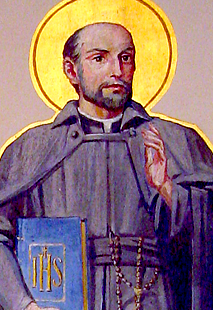 John de Brebeuf was born in the diocese of Bayeux in Normandy, France. At the age of twenty four he entered the Jesuit novitiate in Rouen after completing his university studies. In a spirit of humility, he asked to be a brother but was convinced by his superior to be a priest. He taught young boys at the Jesuit college in Rouen from 1619 to 1621 and was ordained on February 19, 1622 and appointed Treasurer of the college in the same year.
John de Brebeuf was born in the diocese of Bayeux in Normandy, France. At the age of twenty four he entered the Jesuit novitiate in Rouen after completing his university studies. In a spirit of humility, he asked to be a brother but was convinced by his superior to be a priest. He taught young boys at the Jesuit college in Rouen from 1619 to 1621 and was ordained on February 19, 1622 and appointed Treasurer of the college in the same year.
Fr Brebeuf responded to the Franciscan Recollects appeal for priest and brothers from other religious orders to assist in the evangelisation of the native population of North America in 1624 and the tall rugged Jesuit was among the first group of Jesuits to leave their homeland in 1625 to serve in the Huronia mission. When they arrived in Quebec in mid 1625, he quickly learned to adjust himself to the native way of travel and diet. And by the first summer Fr Brebeuf and another Jesuit and a Franciscan offered to accompany the Hurons who came to Cap de la Victoire to barter for trade goods, back to their homeland. The Hurons were willing to take the other two but not Fr Brebeuf as he was too big for their canoes and only gave in when the missionaries offered enough gifts to overcome their reluctance. When they came to cascades or places where they had to carry the canoes and all the gear overland, Fr Brebeuf’s great strength won his hosts’ admiration and they named him “Echon”, “the man who carries the load”.
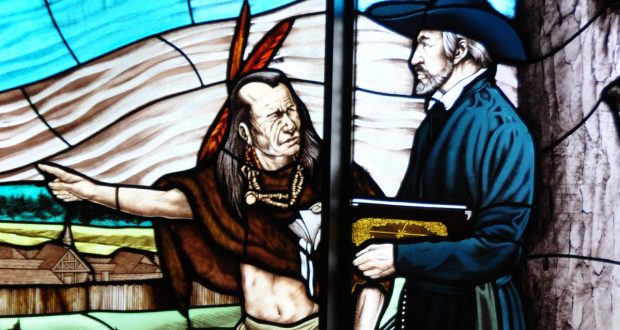 Fr Brebeuf spent the next two years learning the Huron language and their customs and beliefs. He was soon able to write Huron grammar, translated a catechism and prepared a phrase book. However his initial converts were only the dying whom he baptised. His missionary efforts were cut short when he was sent back to France when the English and French ended their war.
Fr Brebeuf spent the next two years learning the Huron language and their customs and beliefs. He was soon able to write Huron grammar, translated a catechism and prepared a phrase book. However his initial converts were only the dying whom he baptised. His missionary efforts were cut short when he was sent back to France when the English and French ended their war.
For two years Fr Brebeuf resumed teaching at the college in Rouen but he returned to Canada when it was restored to France. The Huronia welcomed Fr Brebeuf at a village named Taendeuiata as they were delighted that he had kept his promise to return. There the three priests and five lay helpers who made up the missionary community constructed a cabin as their lodging. Fr Brebeuf taught the others in his community the Huron language and customs. They started their missionary work, working with children during the day and adults at night. After a year of hard work, they had baptised twelve people, four infants and eight adults just as they were dying.
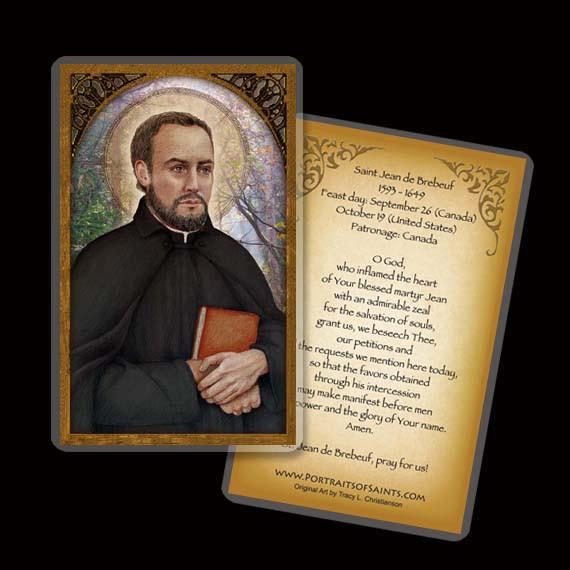 There was competition between Christianity and native religion. When drought hit the land, the native religious leaders blamed it on the crucifix on the priests’ cabin. The Jesuits countered with a novena and a procession around the village and when rain came, they interpreted it as an answer to their prayers. When Fr Isaac Jogues arrived in 1636, a smallpox epidemic broke out among the Jesuits and their helpers and then spread to the Hurons. The epidemic lasted all winter and during that time the Jesuits baptised more than a thousand people, all at the point of death. Some Hurons blamed the Jesuits for causing the epidemic in order to make conversions.
There was competition between Christianity and native religion. When drought hit the land, the native religious leaders blamed it on the crucifix on the priests’ cabin. The Jesuits countered with a novena and a procession around the village and when rain came, they interpreted it as an answer to their prayers. When Fr Isaac Jogues arrived in 1636, a smallpox epidemic broke out among the Jesuits and their helpers and then spread to the Hurons. The epidemic lasted all winter and during that time the Jesuits baptised more than a thousand people, all at the point of death. Some Hurons blamed the Jesuits for causing the epidemic in order to make conversions.
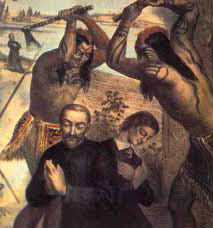 When Fr Brebeuf started a mission at Ossossane, the council of village chiefs blamed him for the epidemic and decided that he and his missionaries should die. Fe Brebeuf moved to the mission headquarters at Sainte-Marie and began work with another tribe, the Neutrals, but he had to flee to Quebec after he was accused of plotting with Herons’ enemies, the Seneca Clan of the Iroquois, to betray his hosts. The danger from the Iroquois was escalating and Frs Isaac Joques and Anthony Daniel had already been martyred.
When Fr Brebeuf started a mission at Ossossane, the council of village chiefs blamed him for the epidemic and decided that he and his missionaries should die. Fe Brebeuf moved to the mission headquarters at Sainte-Marie and began work with another tribe, the Neutrals, but he had to flee to Quebec after he was accused of plotting with Herons’ enemies, the Seneca Clan of the Iroquois, to betray his hosts. The danger from the Iroquois was escalating and Frs Isaac Joques and Anthony Daniel had already been martyred.
In Sep 1648, Fr Gabriel Lalemant joined the mission and he and Fr Brebeuf left Sainte-Marie for their weekly tour of the missions on March 15, 1649 and spent the night at Saint Louis Village. During the night, the Iroquois attacked a nearby village and the Hurons sent their women and children to hide in the forest. Frs Brebeuf and Lalemant chose to stay with the men, who were mostly Christians.
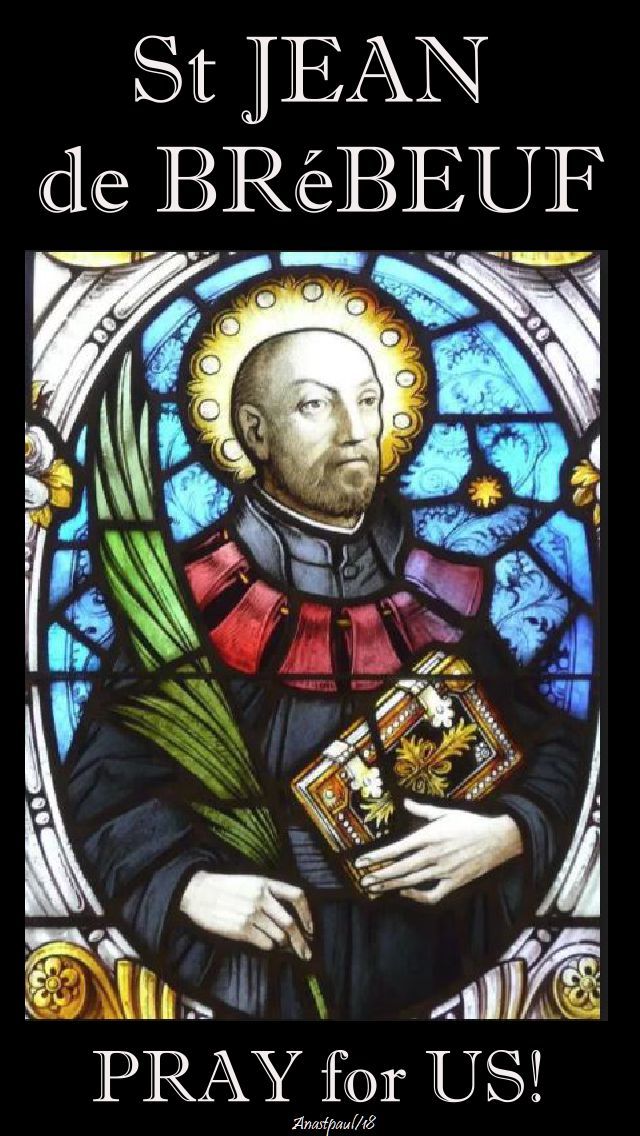 At dawn on March 16 the Iroquois swarmed the palisades and before long Saint Louis came under their control and the Hurons who were mostly Christians were taken prisoner. A renegade Huron informed the Iroquois that they had finally captured the mighty Echon and that he deserved the choicest torture they could imagine. The Iroquois slaughtered the sick and aged in their cabins and set fire to the village. The missionaries were stripped, had their fingernails torn out and fingers chewed and were forced to run naked through the winter snow and endured the cold March winds.
At dawn on March 16 the Iroquois swarmed the palisades and before long Saint Louis came under their control and the Hurons who were mostly Christians were taken prisoner. A renegade Huron informed the Iroquois that they had finally captured the mighty Echon and that he deserved the choicest torture they could imagine. The Iroquois slaughtered the sick and aged in their cabins and set fire to the village. The missionaries were stripped, had their fingernails torn out and fingers chewed and were forced to run naked through the winter snow and endured the cold March winds.
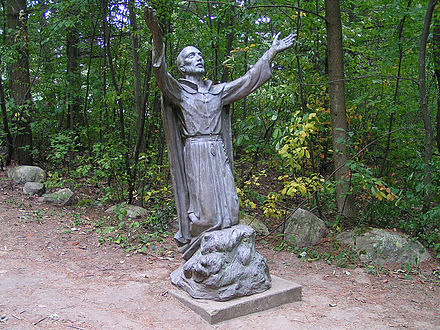 On arrival at Saint-Ignace, the Iroquois were ready and had them run the gauntlet. Throughout Fr Brebeuf encouraged the captive Christians: “Let us lift our eyes to heaven at the height of our afflictions; let us remember that God is the witness of our suffering, and will soon be our great reward.” Having run the gauntlet, Frs Brebeuf and Lalemant were led to two posts which were to be their crosses of martyrdom. Both grasped the posts and prayed, while the Iroquois stabbed them with sharp instruments. The tormentors subjected him to indescribable cruelty such as placing red-hot iron hatchets on his shoulders and when Fr Brebeuf did not yell for mercy, they covered him with resinous bark which they set aflame. All this while, he continued to encourage his fellow Christians to remain strong. Then they cut off his nose and forced a hot iron down his throat to silence him; they poured boiling water over his head in a mockery of baptism and then scalped him, cut off his feet and tore out his heart.
On arrival at Saint-Ignace, the Iroquois were ready and had them run the gauntlet. Throughout Fr Brebeuf encouraged the captive Christians: “Let us lift our eyes to heaven at the height of our afflictions; let us remember that God is the witness of our suffering, and will soon be our great reward.” Having run the gauntlet, Frs Brebeuf and Lalemant were led to two posts which were to be their crosses of martyrdom. Both grasped the posts and prayed, while the Iroquois stabbed them with sharp instruments. The tormentors subjected him to indescribable cruelty such as placing red-hot iron hatchets on his shoulders and when Fr Brebeuf did not yell for mercy, they covered him with resinous bark which they set aflame. All this while, he continued to encourage his fellow Christians to remain strong. Then they cut off his nose and forced a hot iron down his throat to silence him; they poured boiling water over his head in a mockery of baptism and then scalped him, cut off his feet and tore out his heart.
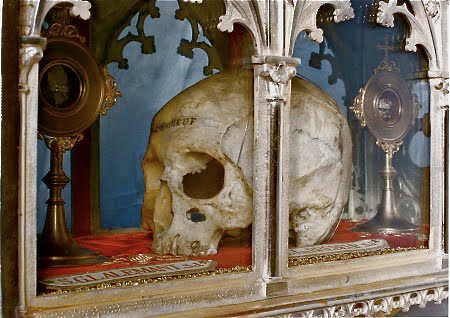 Fr Brebeuf, the “Apostle to the Hurons” died after spending twenty years in New France at the age of forty-six. He longed for a martyr’s death and that grace was not denied him.
Fr Brebeuf, the “Apostle to the Hurons” died after spending twenty years in New France at the age of forty-six. He longed for a martyr’s death and that grace was not denied him.


